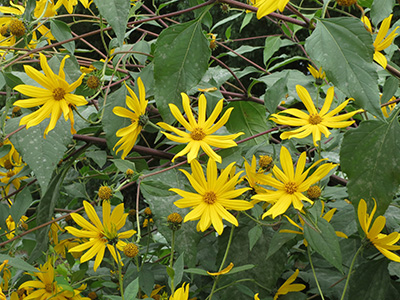Jerusalem artichokes: Tasty and versatile
Despite its’ name, Jerusalem artichokes have no connection to Jerusalem and are not an artichoke, but they are very versatile and good to eat.

This spring, I acquired a few pots of Jerusalem artichokes (Helianthus tuberosus). Honestly, I had heard of them and seen them growing along a few roadsides, but didn’t really know anything about them, so I decided to do a little research. They are in the genus Helianthus, the same genus as sunflowers. I planted them and they grew very nice foliage, their leaves looked like sunflower leaves and they had yellow flowers, which were quite prolific, blooming late in the season. I liked the flowers as they bloomed well after my other sunflowers.
Jerusalem artichokes are native to eastern North America and some historians think they may have originated in the Ohio and Mississippi River valleys. Native Americans grew them along with corn and beans. Despite its’ name, they have no connection to Jerusalem and are not an artichoke. They are often called sunchokes and cultivated for their nutritious and fleshy tuber.
A tuber is an underground swollen stem. Jerusalem artichokes’ tubers can be brown, white, red or purple. Their inner flesh is white. The tuber is a knobby root that resembles ginger. The tubers are smaller, sweeter and crisper than potatoes. They have a nutty flavor and good nutritional value. They can be eaten raw or cooked. They have a high level of inulin, which is a prebiotic fiber with medicinal properties. It can stimulate growth of bifidobacteria, which fights harmful bacteria and helps reduce certain carcinogenetic enzymes.
Jerusalem artichokes are very versatile. You can eat them raw or cooked. They can be mashed, roasted or sautéed. They can be dried and ground into flour.
 Here are a few more things I learned about this native crop:
Here are a few more things I learned about this native crop:
- Native Americans cultivated Jerusalem artichokes as a food source.
- They are grown in many parts of the world. Each root can produce up to 75 and as many as 200 tubers during a year.
- This is a perennial vegetable, which means you don’t have to replant it every year; it seeds itself again and again. It doesn’t need much care while it’s growing. All you have to do is reap the harvest at the end of the season.
- They can become invasive and will grow in any type of soil and with little water.
- Research has shown that the tubers contain more protein than soybeans, corn, wheat or beans. It also contains small levels of some valuable B-complex group of vitamins such as folates, pyridoxine, pantothenic acid, riboflavin and thiamin.
- Jerusalem artichokes are a very good source of minerals and electrolytes, especially potassium, iron and copper.
- They can also be used as animal feed. You can feed the leaves, stems and blossoms to your sheep, goats, pigs and cattle. The leaves and stems contain 28 percent protein. That’s more than twice the amount of protein in corn.
With the three Jerusalem artichokes I planted, I enjoyed lush foliage that was a great screen and had awesome yellow flowers late in the season. I also harvested a large amount of tubers, and fed my cattle the foliage, which they enjoyed.
Oven Caramelized Jerusalem Artichokes recipe
This is the recipe I used for my first venture into cooking with Jerusalem artichokes. They were quite tasty.
- Serves: 4
- Preparation time: 1 hour
- Cooking time: 45 minutes
Ingredients
- 2 pounds Jerusalem artichokes
- 2 teaspoons lemon juice
- 1/4 cup olive oil
- 1 teaspoon kosher salt
- 1 teaspoon freshly ground black pepper
Preparation steps
- Step 1. Rinse the Jerusalem artichokes under running water and rub to remove any obvious surface grit.
- Step 2. Put the artichokes in a large bowl, add enough cold water to cover and add lemon juice. Let the Jerusalem artichokes soak for about 45 minutes.
- Step 3. Scrub the soaked artichokes with a vegetable brush to remove any loosened dirt. Trim 1/8 inch off the cut end and the tips of any nodules that appear rough or “dirty.” Cut each artichoke in half lengthwise and return to the cold water/lemon bath.
- Step 4. Preheat oven to 350 degrees Fahrenheit.
- Step 5. In a large bowl, whisk together the olive oil, kosher salt and freshly ground black pepper. Drain the artichokes, dry them with a towel and add them to the olive oil mixture. Toss to coat completely and dump the entire contents of the bowl onto a large baking sheet, turning each artichoke cut side down. Roast for 45 minutes on the center rack of the oven.
- Step 6. When done, let them cool for a couple of minutes and then use a metal pancake turner to transfer to a serving platter.
Serve alone as you would with roasted potatoes or with your favorite dipping sauce.
For more information on interesting roots you can eat, you might enjoy “Roots: The Definitive Compendium with more than 225 Recipes” by Diane Morgan. In this book, Morgan explores the fascinating world of culinary roots.



 Print
Print Email
Email


